June Diagnostic Lab Preview
Problems we begin to see this month
In June we continue to see most of the plant problems we discussed in May, along with some new problems that announce themselves this month. The Fairfax County Masters Gardeners’ diagnostic lab prepares monthly reports that highlight and address these problems so that master gardeners working at plant clinics can share recommendations with the public. The reports are republished here to assist experienced gardeners in identifying and treating plant problems. Please remember to refer only to the Virginia Cooperative Extension 2022 Pest Management Guide for pesticide recommendations.
Anthracnose on Trees
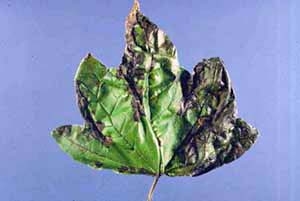 Anthracnose diseases are caused by several closely related fungi (mostly in the genera Gnomonia, Gleosporum, and Glomerella). The most common symptoms of these diseases are dead areas or browned blotches on the leaves. On some trees (like ash) the diseased leaves will drop and the tree will leaf out again. The new, summer leaves are generally unaffected.
Anthracnose diseases are caused by several closely related fungi (mostly in the genera Gnomonia, Gleosporum, and Glomerella). The most common symptoms of these diseases are dead areas or browned blotches on the leaves. On some trees (like ash) the diseased leaves will drop and the tree will leaf out again. The new, summer leaves are generally unaffected.
Some forms of anthracnose can be much more serious. Discula anthracnose on dogwood and Sycamore anthracnose can also affect buds and twigs, moving into stem tissue and causing stem cankers.
Control Recommendations
Anthracnose diseases are difficult to control and, on most shade trees, they are seldom severe enough to warrant control measures. Controls are necessary for Discula anthracnose on dogwoods and Sycamore anthracnose. If we experienced prolonged damp weather in late winter and early spring, spraying to control anthracnose disease may also be appropriate on other trees that have experienced severe defoliation in previous years.
The Pest Management Guide chemical recommendations for control of Anthracnose diseases on ornamentals are found in Table 4.1, General Guideline for Pesticide Selection (pg. 4-7), but more specific recommendations can also be found in Table 4.2, Fungicide Use, for Ash, Beech and Birch, Buckeye, Dogwood, Maple, Oak, Sycamore, and Black Walnut.
More Information
Anthracnose on Shade Trees, Penn State Extension
Tomato Blights
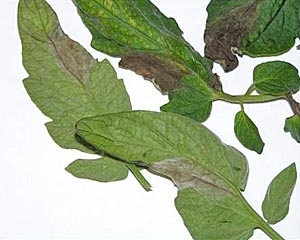
Light gray coating of mycelial growth can be seen on the undersides of leaves with Late Blight
We see samples of both Early Blight and Late Blight starting in June, mostly on tomatoes but also on potato samples.
- Early Blight – Caused by the fungus Alternaria solani, early blight produces tan to brown lesions which can take on a target-like appearance as they expand. Spots are often surrounded by yellowed leaf tissue. Early blight usually appears on lower (oldest) leaves first.
- Late Blight – Caused by the water-mold Phytophthora infestans (a fungus-like organism), late blight first appears as irregular, greenish-black, water-soaked areas, enlarging into pale green to tan to brown lesions on the leaves, petioles, and stems. Late blight usually attacks new growth first. Stem lesions also appear early in the infection. Plants with late blight cannot be saved and should be promptly removed to avoid spreading the infection.
Control Recommendations
Good cultural practices can help tomatoes avoid fungal diseases. Recommended practices include:

Target spot is another common name for Early Blight
- Select disease-resistant varieties.
- Avoid planting tomatoes in the same area where tomatoes, potatoes or peppers were grown last year.
- Give plants good spacing for air circulation and avoid wetting foliage.
- Apply 2 to 3 inches of mulch around each plant to reduce splashing of soil and spores onto lower parts of the plant.
- In the fall, clean up all plant debris (including potato tubers in the soil) to reduce overwintering inoculum.
- Eliminate volunteer tomatoes, potatoes and solanaceous weeds (nightshades) as they can be a source of late blight spores.
- Monitor plants frequently for evidence of infection.
The Pest Management Guide chemical recommendations for control of vegetable diseases are found in Table 2.4 under the affected plants.
More Information
Early Blight of Tomatoes, Virginia Cooperative Extension Publication 450-708
Late Blight of Tomatoes and Potatoes, Virginia Cooperative Extension Publication 450-605
Late Blight ‘Imitators’, Cornell University Extension Plant Diagnostic Clinic
Leaf Scorch
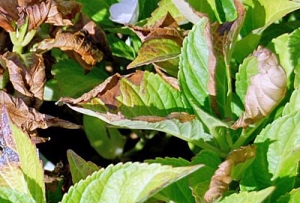 Historically, this is a problem that does not usually appear until July, but if the year’s June’s weather is hot and dry, you may start seeing samples with leaf scorch this month, especially on hydrangeas and Japanese maples.
Historically, this is a problem that does not usually appear until July, but if the year’s June’s weather is hot and dry, you may start seeing samples with leaf scorch this month, especially on hydrangeas and Japanese maples.
Physiological leaf scorch is caused by too much sun and/or too little water. During dry weather, when there is insufficient moisture in the soil, plants can suffer browning of leaf tips and margins in high temperatures and drying winds. Symptoms may be more severe on the exposed parts of the plant. Clients may also have noticed wilting before the browned leaf edges.
Among plant samples we’ve received, the problem is most common when shade plants (like hydrangeas) or understory plants (like dogwoods) are planted where they get too many hours of mid-day and afternoon sun. Even with moist soil, they are not capable of supplying water to the leaves as fast as moisture is lost in hot weather.
The most typical symptoms are browned leaf margins and tips. On some plants, there is also an overall yellowing of leaves. On hydrangeas, symptoms can also include irregular, dry, brown blotches and spots that appear burned, as if frost damaged or injured by sprays. If the damaged areas look clean, without evidence of insects or fungus, then be sure to ask the client about watering and sun exposure.
Control Recommendations
Except for cactus, established sun tolerant plants may need supplemental water during prolonged dry spells. Water needs to be applied slowly so it can penetrate 5 to 6 inches into the soil.
For plants that prefer shade or part shade, the best solution is to move the plant to a shadier area and replace it with a more sun-loving plant. Another alternative would be adding a larger plant or structure to the southwest to provide added shade. As long as the plant receives too much sun, it will need supplemental water and even then may suffer some scorching in hot weather.
More Information
Leaf Scorch of Ornamental Trees and Shrubs, University of Missouri Extension publication G6881
Physiological Leaf Scorch, Cornell University article
Cedar RustsIn our area, there are three major rust diseases caused by fungi in the Gymnosporangeum genus: Cedar-Apple Rust (Gymnosporangium juniperi-virginianae), Cedar-Hawthorn Rust (Gymnosporangium globosum), and Cedar-Quince Rust (Gymnosporangium clavipes). We have seen all three in recent years. All three disease organisms require alternate hosts to complete their reproductive cycle – one in the Juniperus genus (Eastern Red Cedar or other juniper) and one in the family Rosaceae. Among Rosaceous hosts, Cedar-Apple rust primarily affects apples and crabapples (and rarely hawthorns). Cedar-Hawthorn rust affects apple, crabapple, most hawthorns, pear, quince, serviceberry and mountain ash (Sorbus). Quince rust has the widest Rosaceous host range, affecting 480 species in 11 genera, including hawthorn, apple, crabapple, quince (both Cydonia and Chaenomeles), pear, serviceberry, and mountain ash. Signs/Symptoms on Juniper hosts Signs/Symptoms on Rosaceous hosts |
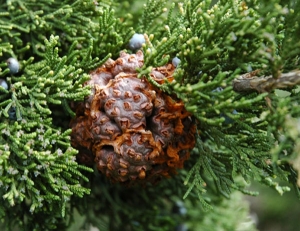 Cedar Apple rust gall beginning to form spore-producing telia on Juniperus host.  Early leaf spot symptoms look similar for both cedar-apple and cedar-hawthorn rust  Cedar quince rust aecia initially appear white, then orange as rust color spores are released |
On fruit, Cedar-apple rust causes only a shallow infection, starting as yellow-orange spots turning green to brown. Cedar-Hawthorn rarely affects fruit, but may occasionally cause rust colored blisters on the fruit surface. Cedar-Quince infects fruit to its core. Short fungal tubes (aecia) develop all over fruit, eventually releasing orange spores. Quince rust will also infect green twigs, causing a swelling, which also produces spores. Infected twigs usually die by the end of the second year. Twig infections by the other two rusts are less common and less damaging.
Control Recommendations
Disease prevention best begins by pruning out the galls from the Juniperus host before the spore horns develop in spring. Since spores can travel two miles or more, it is not usually feasible to remove all potential hosts or their galls, but the disease on the rosaceous host will generally be less severe the farther it is from the sporulating Juniperus plant.
Control recommendations for these diseases on edible fruits:
- Control recommendations for rusts on apple trees are found in the apple spray schedule in Table 3.5.
- The PMG contains no recommendations for these rusts on pears or other edible fruits other than apples. When fruit will be eaten, Virginia Cooperative Extension has advised us to give the following recommendation: “Suppress this disease by applying one application of a copper product with a broad tree fruit label at 1/4″ greentip and repeated applications of sulfur until around June 10. Follow label precautions, particularly for spraying sulfur at high temperatures, which can injure the tree.” (1/4″ greentip means when about 1/4″ of the new leaves are peeking out of the bud.)
Control recommendations for these diseases on ornamental hosts:
- Table 4.2 has recommendations for cedar-apple rust on crabapples.
- Table 4.2 has recommendations for cedar-quince rust on hawthorns.
- For other disease/host combinations on rosaceous hosts, refer to Table 4.1, general recommendations for Rusts.
There are no recommended chemical controls for these rusts on Juniperus hosts. Control should focus on pruning out galls.
More Information
Cedar-Apple Rust, Cornell University Cooperative Extension Plant Disease Diagnostic Guide
Cedar apple rust and other Gymnosporangium rusts, University of Minnesota Yard and Garden Brief
Diseases of Landscape Plants: Cedar Apple and Related Rusts, Purdue Extension
Rose Slugs
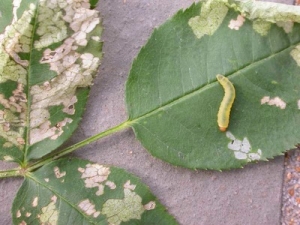 The yellow-green, caterpillar-like insect with an orange head seen eating rose leaves is the larvae of the European rose slug sawfly (Endelomyia aethiops), commonly called rose slugs. The larvae grow from 3/8 to 3/4 inches in length.
The yellow-green, caterpillar-like insect with an orange head seen eating rose leaves is the larvae of the European rose slug sawfly (Endelomyia aethiops), commonly called rose slugs. The larvae grow from 3/8 to 3/4 inches in length.
This pest feeds on the upper surface of the leaf, eating only the soft parts, leaving “windows” in the leaf where you see the transparent leaf surface and a network of veins. These skeletonized leaves turn brown and crisp. Leaf loss from this insect is usually minor and largely cosmetic.
Two other sawfly species cause similar damage in mid- to late-summer. Bristly rose slugs (Cladius difformis) skeletonize leaves by feeding from the undersides of the leaves and later chew holes through the leaves. Curled rose slugs (Allantus cinctus) initially feed by skeletonizing the leaves, but eventually defoliate entire leaflets except for the largest veins.
Control Recommendations
The Pest Management Guide pesticide recommendations for control of this insect are found in Table 4.5 under Rose slug. (Please disregard the Table 4.7 entry for methoxychlor (Marlate), as this product’s registration expired in 2002 and it is no longer available for sale.)
More Information
Rose Insects and Related Pests, Clemson Cooperative Extension, HGIC 2107
Black Spot on Roses
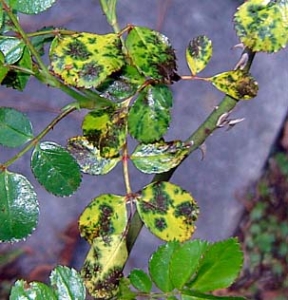 Once you learn it, black spot is pretty easy to identify. Caused by the fungus Diplocarpon rosea, black spot begins as small black spots with indistinct, “feathered” margins. Spots expand up to about 1/2 inch and sometimes coalesce. The leaf usually turns yellow, starting around the spots. This disease can cause severe defoliation of the rose bush.
Once you learn it, black spot is pretty easy to identify. Caused by the fungus Diplocarpon rosea, black spot begins as small black spots with indistinct, “feathered” margins. Spots expand up to about 1/2 inch and sometimes coalesce. The leaf usually turns yellow, starting around the spots. This disease can cause severe defoliation of the rose bush.
This fungus is encouraged by wet leaves and poor air circulation. Gardeners planning on adding roses to their yard should consider selecting a Black Spot resistant variety.
Control Recommendations
Practice good sanitation procedures by picking off affected leaves and cleaning up the fallen leaves under the plants. Black spot can also cause blackened areas on the canes. If this occurs, the cane should be cut back to an inch below the affected areas. Disinfect the pruners with a 10 percent bleach or 70 percent alcohol solution after each cut to avoid spreading the disease.
The Pest Management Guide chemical recommendations for control of this disease are found in Table 4.1 (page 4-9) under black spot.
More information
Black Spot of Roses, Texas A&M Agrilife Extension publication
Black Spot of Rose, Missouri Botanical Garden
Euonymus Scale
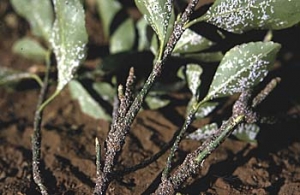 The tiny euonymus scale Unaspis euonymi appears as a white and brown waxy crust on stems and leaves. The brown, oyster shape scales are the mature females and the more populous slender white ones are the males.
The tiny euonymus scale Unaspis euonymi appears as a white and brown waxy crust on stems and leaves. The brown, oyster shape scales are the mature females and the more populous slender white ones are the males.
This is a sucking pest that can cause yellowish areas on leaves and in some cases defoliation of the worst affected stems.
In addition to euonymus, we have also seen this scale on pachysandra samples. It is also an occasional pest of American Bittersweet, English ivy, camellias, boxwood, privet, and honeysuckle, among others.
Control Recommendations
The fertilized adult female overwinters under her protective shell and lays eggs in early spring. Crawlers hatch May 5 to June 10 and a second generation July 1 to 25.
The Pest Management Guide pesticide recommendations for control of this insect are found in Table 4.5 under Scale Insects, Euonymus Scale. Spray when crawlers are present. Spray dates: May 10 to 20, and July 5 to 15. It is important to coat stems and undersides of leaves and that sprays penetrate to the interior of the shrub.
More Information
Euonymus Scale, Virginia Cooperative Extension Fact Sheet 444-277
Euonymus Scale, Pennsylvania State University Fact Sheet
Septoria Leaf Spot on TomatoesSeptoria leaf spot, caused by the fungus Septoria lycopersici, is one of the early diseases to appear in tomatoes, usually occurring just as plants begin to set fruit. The three photos below show the progression of the disease in tomato leaves. The fruit is not affected unless infection and, as a result, leaf drop are severe. Then the tomato may suffer from sunscald. Stems can also be affected. Control Recommendations Remove weeds from area that are also members of the Solanaceae family such as nightshade and jimson weed. The Pest Management Guide chemical recommendations for control of vegetable diseases are found in Table 2.4 under the affected plants. More Information |
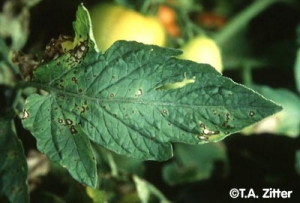 Disease begins as small dark spots on lower leaves that may also be yellowing. 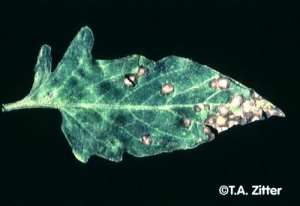 As spots increase in size and go to dark brown then tan, leaves may drop off. 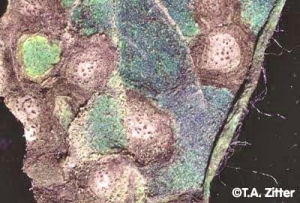 Eventually tiny black spots occur in discolored area; these are spore bearing pycnidia. |
Prepared by: Susan McCullough
Fairfax County Master Gardeners Association sponsored by Virginia Cooperative Extension
Release Date: June 2013
Links updated: May 2015